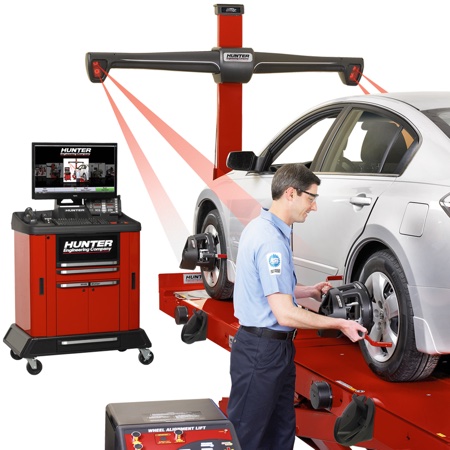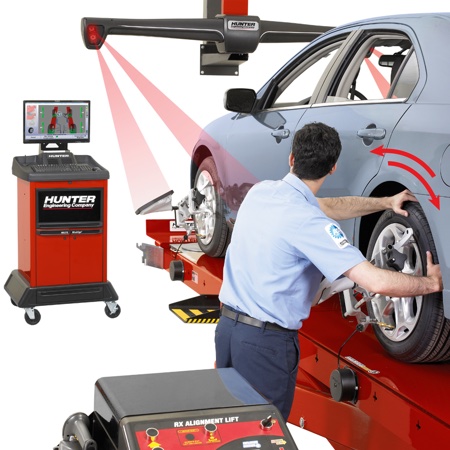From Wikipedia:
Wheel alignment, sometimes referred to as breaking or tracking, is part of standard automobile maintenance that consists of adjusting the angles of the wheels so that they are set to the car maker's specification. The purpose of these adjustments is to reduce tire wear, and to ensure that vehicle travel is straight and true (without "pulling" to one side). Alignment angles can also be altered beyond the maker's specifications to obtain a specific handling characteristic. Motorsport and off-road applications may call for angles to be adjusted well beyond "normal" for a variety of reasons.[1]
All new vehicles leave the factory with their alignment checked and adjusted. Usually the technician paints the heads of the adjustment hardware to show it has been set, also to show if it has moved later on.[citation needed] It is advisable to do the alignment of the car after the first 5000 km, since all the suspension get set. Failure to do this may result in the camber and toe specifications drifting outside the manufacturer's limit. This may lead to vehicle pulling and tire wear.
Initially consumers may not notice these defects but after usage of some days or running some kilometers it can cause uneven tire wear and a pull/drifting to the left or right.[citation needed] Tire wear leads to frequent replacement of tires thus adding to running cost for the consumer. Vehicle pulling causes irritation and/or fatigue while driving the car.
Under normal driving conditions many vehicles can go 50 000 km+ before they need a new set of tires. To reach that mileage wheel alignment must be checked every 10 000km. Any severe driving incidents, or changed suspension components would also warrant a check.
The typical alignment on an economy sedan takes about an hour under ideal circumstances. A utility or performance vehicle may require additional labor. When fasteners and hardware are rusted/seized, extra time may be required and/or parts may need to be replaced.
In the same fashion that you will wear out your shoes if you walk only on the inside or outside edge, so your tires may become worn if not within allowed specifications. Many performance vehicles sacrifice tire life for driving performance.
Braking distance, ride quality, and even fuel economy are all affected by the correct inflation and rotation of tires.
If your vehicle squeals while turning corners on dry pavement, it is probably time to have your alignment checked.
Changing rims and tires will normally not affect the alignment but will affect secondary angles.
Primary angles
The primary angles are the basic angle alignment of the wheels relative to each other and to the car body. These adjustments are the camber, caster and toe. On some cars, not all of these can be adjusted on every wheel.
These three parameters can be further categorized into front and rear (with no caster on the rear, typically not being steered wheels). In summary, the parameters are:
Front: Caster (left & right)
Front: Camber (left & right)
Front: Toe (left, right & total)
Rear: Camber (left & right)
Rear: Toe (left, right & total)
Secondary angles
The secondary angles include numerous other adjustments, such as:
SAI (Steering Axis Inclination) (left & right)
Included angle (left & right)
Toe out on turns (left & right)
Maximum Turns (left & right)
Toe curve change (left & right)
Track width difference
Wheelbase difference
Front ride height (left & right)
Rear ride height (left & right)
Frame angle
Setback (front & rear)
Setback is the difference between right side and left side wheelbase length. It can also be measured as an angle. Setback less than the manufacturer specified tolerance (for example about 6mm) does not affect car handling. That's because, when the vehicle is turning, one wheel is ahead of the other by several centimetres and therefore the setback is negligible. There are even some car models with different factory setting for right and left side wheelbase length, for various design reasons. An off-spec setback may occur because of a collision or a difference between right and left caster.[2][3]
Measurement
A camera unit (sometimes called a "head") is attached to a specially designed clamp which holds on to a wheel. There are usually four camera units in a wheel alignment system (a camera unit for each wheel). The camera units communicate their physical positioning with respect to other camera units to a central computer which calculates and displays.
Often with alignment equipment, these "heads" can be a large precision reflector. In this case, the alignment "tower" contains the cameras as well as arrays of LEDs. This system flashes one array of LEDs for each reflector whilst a camera centrally located in the LED array "looks for" an image of the reflectors patterned face. These cameras perform the same function as the other style of alignment equipment, yet alleviate numerous issues prone to relocating a heavy precision camera assembly on each vehicle serviced.
References
• "Tire Maintenance".
•http://www.carparts.com/alignment.htm#Set%20Back
•http://www.fasep.it/english/support/tech_talks/tt001_set-back.asp
This article uses material from the Wikipedia article "Metasyntactic_variable", which is released under the Creative Commons Attribution-Share-Alike License 3.0.




